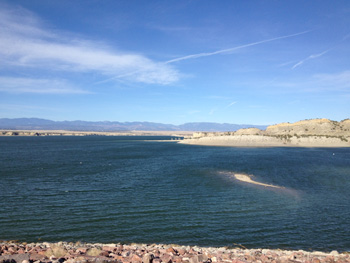
Water from the Catlin Canal is stored in Pueblo Reservoir. Photo Courtesy of U.S. Bureau of Reclamation
In spring 2016, tests showed that groundwater used for drinking in Security, Widefield and Fountain had been contaminated with high levels of perfluorinated compounds or (PFCs). PFCs are thought to have been released during firefighting drills at Peterson Air Force Base, north of Security-Widefield, between 1970 and 1990. Over the past year, to avoid contaminated groundwater supplies and ensure residents received safe, clean drinking water, water managers have been serving up their limited surface water—available thanks, in part, to an alternative transfer method (ATM).
In May 2016, the regulatory level of PFCs, set by the Environmental Protection Agency (EPA), was changed from 400 parts per trillion (ppt) to 70. Water supplies for the communities of Security, Widefield and Fountain fell well within the old limit, but exceeded the new 70 ppt. Exposure to PFCs can cause birth defects, heart disease, liver disease and some cancers. The news of high levels of PFCs caused concern among residents. They were offered emergency supplies of bottled water, then even when the water providers shifted to new safe supplies, people began buying their own water or filtering the water.
There are four wells that supply about 5 percent of the city’s water supply while the remaining 95 percent comes from water from the Fryingpan-Arkansas Project, a transbasin diversion. So, while groundwater is a major source of drinking water in these communities, they do have surface water supplies. “We don’t use groundwater in the winter, just surface water. During the summer, we get about 30 percent from groundwater [in a normal year],” says Michael Fink, water superintendent for the City of Fountain. After discovering that PFC levels exceeded the new federal limit, all groundwater wells were turned off in all three communities, forcing them to rely solely on surface water from Pueblo Reservoir.
In 2015, the Colorado Water Conservation Board (CWCB) approved a lease of water from the Catlin Canal to Security, Fountain and Fowler under House Bill 13-1248. The bill allowed for pilot projects to test out lease-fallowing over a 10-year span. On the Catlin Canal, farmers near Rocky Ford who are participating in the pilot fallow up to 30 percent of their land and lease that water, which would normally be used for irrigation, to the municipalities. The water is stored in Pueblo Reservoir and then pumped 30 miles north using the Fountain Valley Conduit. For Fountain and Security, the Catlin Canal pilot project came at the perfect time as cities would use this extra water in 2016 to make up for the hole in their supply caused by contaminated groundwater. Fountain and Security have received about 158,000 acre-feet from the Catlin Canal. Although this water comes at a higher cost, $500 per acre-foot, than other surface water resources, which typically range from $150 to $300 per acre-foot, Fountain and Security used this supply during peak season, when their communities desperately needed the extra water. In order to prevent a rate increase for customers, Fink says they focused heavily on conservation to make sure the surface water would be enough,
“Because I can’t use groundwater, I have no redundancy. Everything depends on this pipe and three pump stations,” Fink says.
This ATM has given these communities a more diverse water portfolio. This is critical when one resource is no longer usable and provides protection against a water emergency that could result in a shortage and rate increase for customers. The Catlin Leasing-Fallow Pilot Project was agreed to in 2012 and deliveries began in 2014. It is set to expire in 2022. Six farms across 902 acres along the Catlin Canal in Rocky Ford are participating in the pilot, leasing out irrigation water in exchange for financial compensation. Each year up to 30 percent of the land can be fallowed, or no more than 271 acres per year—in 2017, 239 acres were fallowed. The water saved from fallowing the land is stored in Pueblo Reservoir and later delivered and used by municipalities. To mimic return flows from the canal, recharge ponds and augmentations stations are used to ensure no injury to downstream users. Municipalities are allowed 500 acre-feet per year, although there’s no guarantee that they’ll receive that full amount, and they haven’t yet.
“We worked out the deal before the PFCs. Can you conserve your water out of a crisis? Yes, but you’ve got to start 10 years ago. Actually, we started 15 years ago,” Fink says. “You don’t know when a crisis is coming, how big it’s going to be and how hard it’s coming down on you.”
ATMs can provide a backup plan for when things do go wrong for water providers. In this case, it adds a little diversity to Fountain’s water portfolio. If the water goes unused one year, it will still be stored for the next. Because of this, Fountain has made an offer to the Super Ditch Co. to extend as long as 40 years as water utilities often plan past 10 years.
But ATMs, often touted as win-win solutions, provide perks to farmers also. When crop prices are low, leasing their irrigation water gives farmers an alternative to stay profitable and keep their farms going.
Read more about the public health challenges in Fountain, Security and Widefield in the Fall 2016 issue of Headwaters magazine and look forward to reading more about ATMs in the next issue of Headwaters magazine. And stay posted for more ATM coverage in the upcoming Fall 2017 issue of Headwaters. 

 Print
Print
Reblogged this on Coyote Gulch.